- Joined
- Jul 21, 2016
- Messages
- 3,050
What's the asking price?? Does it have the sheath or box??I am a buyer
The BladeForums.com 2024 Traditional Knife is ready to order! See this thread for details:
https://www.bladeforums.com/threads/bladeforums-2024-traditional-knife.2003187/
Price is $300 $250 ea (shipped within CONUS). If you live outside the US, I will contact you after your order for extra shipping charges.
Order here: https://www.bladeforums.com/help/2024-traditional/ - Order as many as you like, we have plenty.
What's the asking price?? Does it have the sheath or box??I am a buyer
Sass - I believe you are about 20% or so too low on your valuation.
I don't know if it would be worth $100 but I do believe it to be somewhere in between $80-$100.
I have several of each in good used condition and a few NIB. NIB I would value at close to $200 if not a touch more.
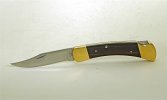
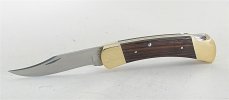
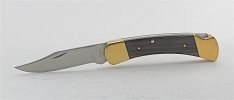
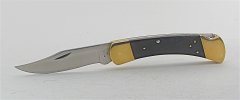

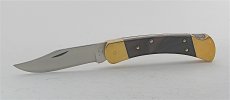
AmazingIt’s tempting to look at the handle pins on the Two Dot knives and ignore the reasons for the changes of the handle pin configuration. Here is my interpretation.
The 5thVersion 110s used a forged frame which required a lot of handwork to flatten and smooth the frame before attachment of the scales using glue and handle pins. In about 1974, Buck switched to a sintered frame that eliminated all of that handwork. Initially the scales were attached the same as on the 5thVersion. However, it soon was decided that glue was not necessary on the sintered frames—glue was eliminated and the scales were attached using only the handle pins.
These first sintered frame knives used the same blade configuration as the 5th Version Variation 3 knives and were stamped “BUCK/110/USA”—there were no dots. I call them Transition variations. If you compare the 5thVersion knives with the sintered frame knives, an obvious difference is that the sintered frame is much wider than the forged frame. Since glue was no longer used, the pins were the only thing stabilizing the scales and holding them on the frame.
The Two Dot knives used the same frame as the Transition variations. The difference is the major change in the shape of the blade tang, which also required a change in the lockbar. This was done to eliminate legal issues due to the “gravity” knife problem. The handle pin arrangement on the Two Dot Variation 1 was the same two pin arrangement as on the 5thVersion and Transition knives. This means that the wider wood scale on the sintered frame knives was stabilized by only one pin centered near the rear bolster. These scales were solid ebony, not the laminated and more stable Dymondwood used later. Shrinking and swelling across the grain, especially near the rear bolster, resulted in unsightly gaps between the scale and the frame.
The four pin configuration of the Two Dot 2nd Version was an attempt to stabilize the scales and eliminated the unsightly gaps. With pins nearer the edge of the scales, greater stabilization resulted.
My understanding for the four pin configuration is that when the decision was made to place handle pins closer to the edge of the handle, Buck still had a small inventory of scales drilled for a pin near the center. Rather than throw them out two more holes were drilled resulting in the four pin configuration. Once those scales were used, the three pin configuration became the norm.
It isn’t clear how many of these four pin variations were made, but I have heard a number of less than 500. Whatever the actual number is, there are not many of the Two Dots with four handle pins. As an aside, if you look inside the frame of Two Dot knives, most of them have holes drilled for four handle pins.
Bert
5th Version Variation 3
View attachment 1196162
Transition Variation
View attachment 1196163
Two Dot Variation 1
View attachment 1196164
Two Dot Variation 2
View attachment 1196165
Two Dot Variation 3
View attachment 1196166
Two Dot Variation 4
View attachment 1196167
That member should let go of some laughsJoe said that Buck had a 'pail' of frames for both the 110 and 112 and there were slightly fewer 110's. Up until 2 years ago I had never seen a NIB 112 or a 110 offered for sale. One forum Member has 25 to 30 of each! I got mine from Joe at Altanta in 2009..
I would agree if it had the sheath....I might be lowballin it, I don't believe 100+ by itself.....
Joe said that Buck had a 'pail' of frames for both the 110 and 112 and there were slightly fewer 110's. Up until 2 years ago I had never seen a NIB 112 or a 110 offered for sale. One forum Member has 25 to 30 of each! I got mine from Joe at Altanta in 2009..
Lucky you I wish I had a set
